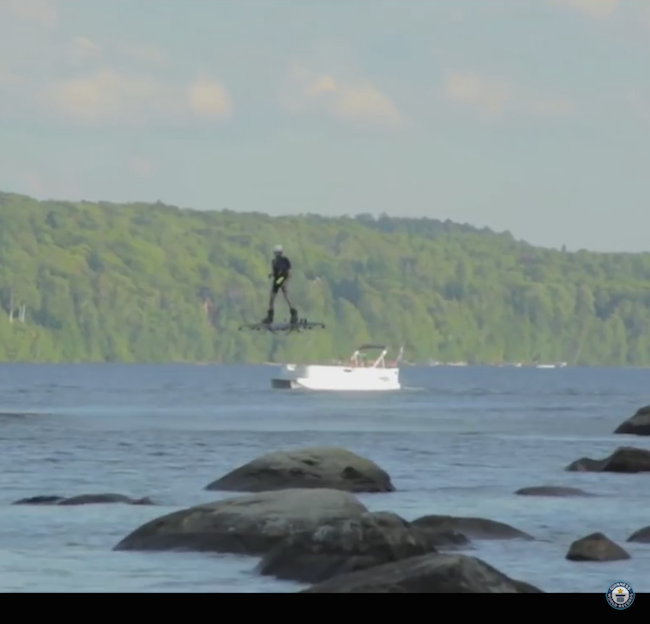Back to the Future! Real-Life Hoverboard Breaks Record

A hoverboard rider recently soared into Guinness World Records after flying a record distance on the futuristic, flying skateboard.
Catalin Alexandru Duru, the inventor of the prototype hoverboard, traveled the length of two-and-a-half football fields (about 905 feet or 375 meters) to achieve the world record title before landing gently in the sparkling water of Quebec's Lake Ouareau. Duru reached a height of 16.4 feet (5 m), but the flying board is allegedly capable of much greater altitudes, said Duru, who told Guinness World Records that his machine could reach "scary heights."
"The prototype can be used anywhere but is usually tested over water because of how dangerously high it can fly (which is ironic considering that the movie joked that it can't)," Duru wrote in a description of a YouTube video of the hoverboard's record-breaking flight. [Hyperloop, Jetpacks & More: 9 Futuristic Transit Ideas]
The movie that Duru referred to is "Back to the Future Part II," the same flick that inspired at least one other iteration of the flying skateboard. In the 1989 classic, Marty McFly (a young Michael J. Fox) flees from a band of bullies on a stolen hoverboard. As Duru noted, McFly's escape plan is almost thwarted when he unsuccessfully tries to hover over a small pond (luckily, the protagonist remembers that swimming is the next best option).
The movie never explains the mechanics of McFly's hoverboard. But since the fictional device only works over land, it may have lifted off the ground by electromagnets, which would (hypothetically, at least) be repelled by magnetic forces from the Earth itself. Duru's real-life flying skateboard is a bit simpler than McFly's: It has a propeller that helps lift it into the air. But just like McFly, Duru controlled the hoverboard using only his feet, he told Guinness World Records.
Last year, a California-based company ran a successful Kickstarter campaign to support the development of a more McFly-esque version of the hoverboard, called the Hendo Hoverboard. This board is equipped with four electrically charged magnets, or electromagnets, that create a magnetic charge when placed over a copper surface. Copper is an inductive material that creates a strong, repulsive magnetic field that forces the board up into the air and allows it to levitate.
Someday, the board could also be made to hover over aluminum, as well as a variety of nonmetal materials that are also inductors, Greg Henderson, the inventor behind this futuristic skateboard, told Live Science in December.
Sign up for the Live Science daily newsletter now
Get the world’s most fascinating discoveries delivered straight to your inbox.
However, for now, the Hendo Hoverboard has limited real-world usefulness thanks to its reliance on inductive surfaces. On the other hand, Duru's record-breaking hoverboard can float over any surface, making it a more practical option for the Marty McFlys of the world (at least until someone figures out how to build that flying DeLorean).
Follow Elizabeth Palermo @techEpalermo. Follow Live Science @livescience, Facebook & Google+. Original article on Live Science.

Elizabeth is a former Live Science associate editor and current director of audience development at the Chamber of Commerce. She graduated with a bachelor of arts degree from George Washington University. Elizabeth has traveled throughout the Americas, studying political systems and indigenous cultures and teaching English to students of all ages.









